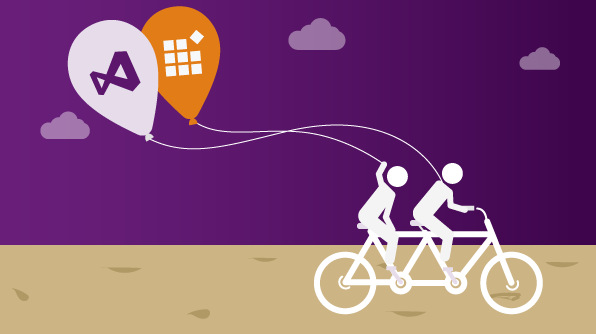
Visual Studio Partner Summit; Source: @LadyQuestAway twitter feed
Having worked at Syncfusion for 15 years, I have had the pleasure of working with Microsoft through various partner levels and programs—each has provided enormous benefits.
When Syncfusion first started up back in 2001, we weren’t yet a VSP partner. On the technical side, we were a Sim-Ship Partner already, meaning that we promised to release a compatible version of our controls within 60 days of a new release of Visual Studio. We continue to be Sim-Ship Partners to this day.
Back then, in 2001, we were able to be listed in the Visual Studio Gallery (now merged with the Visual Studio Marketplace). This can give you great visibility for your new products to a highly targeted audience of developers working with the Visual Studio family of products.
In 2007, we joined the Visual Studio ecosystem at the Alliance Level, which had many additional benefits such as access to the Visual Studio Partner Summit in Redmond, which I’ll detail later, and the possibility of being featured on a Channel 9 show. In fact, our VP, Daniel Jebaraj, was just recently featured in such an episode on Visual Studio Toolbox, where he presented our Xamarin.Forms controls, Metro Studio, and Succinctly series of free technical e-books.
Over the last 16 years, we have moved from the Alliance Level and, as of 2017, we are Premier Partners. At this level, we get great benefits like the ability to get a quote from a Microsoft executive for a press release, requesting a social media post from @VisualStudio, and much more.
If you are a start-up or individual developer, and you haven’t already, you can download the Visual Studio Community Edition as an individual developer. Likewise, Syncfusion offers a community license edition of over 800+ components for individual developers and start-ups.
If you are creating tools or solutions for .NET developers, then you should consider joining the Visual Studio Partner Program, which “provides direct access to business-enhancing marketing and technical resources, previews of upcoming technologies, and key integration scenarios and support for developing products that integrated with Visual Studio®, TFS, Visual Studio Team Services, Visual Studio Code, or Xamarin®,” as per the program website.
There are three levels of the Visual Studio Partner Program—basic, alliance, and premier. You can read more about it at vspartner.com/benefits. If you are a start-up, the basic level would be a good starting point and offers a long list of benefits. As mentioned earlier, a great benefit is the listing of your products on the Visual Studio Marketplace. In addition to the targeted .NET audience, you can show off your “Visual Studio Partner” designation.

VSP members pose for selfie with Laura Quest; Source: @LadyQuestAway
As I said earlier, I was honored last year to attend the Visual Studio Partner Summit in Redmond and learn from the VSP program managers about great benefits, how we can best leverage our relationship with Microsoft®, and upcoming benefits and strategies.
It was great to meet with the other Visual Studio Partners, as well, such as Mobilize.net, LEAD Technologies, and Red Gate. In fact, this group of VSP Program members now have a Gitter forum to share ideas and find ways to collaborate and promote each other, as well. It is nice to be in the program for many years, as it comes with opportunities like this to learn more ways to work with the VSP team and collaborate with other VSP members.
I realize that it may seem overwhelming to start, or you may wonder why a large company like Microsoft® would be interested in promoting your app, product, or tool. That said, please know that Microsoft® is committed to helping entrepreneurs of all sizes grow their businesses. Syncfusion has received many benefits through Microsoft® programs throughout the years and you can do the same!
Let me leave you with a few practical tips that may help you get started:
- Have a dedicated person assigned to manage the Microsoft® relationship. This may not be a full-time job in the beginning, but having one point of contact will be make the process and the relationship much more productive.
- Ensure that your product or products are all listed in the Visual Studio Marketplace. This gains visibility and awareness and may generate some leads for you.
- Participate in VSP calls, webinars, and live events to get access to the latest benefits and learn how you can best leverage them to help grow your business.



